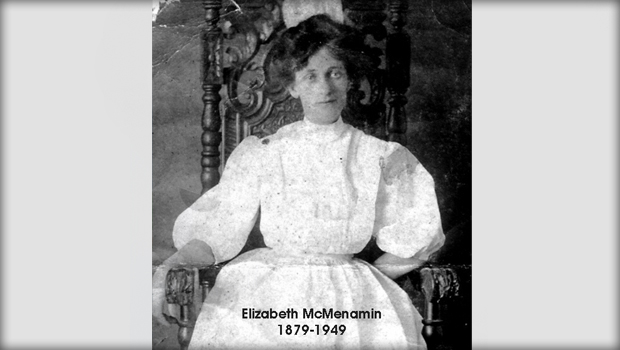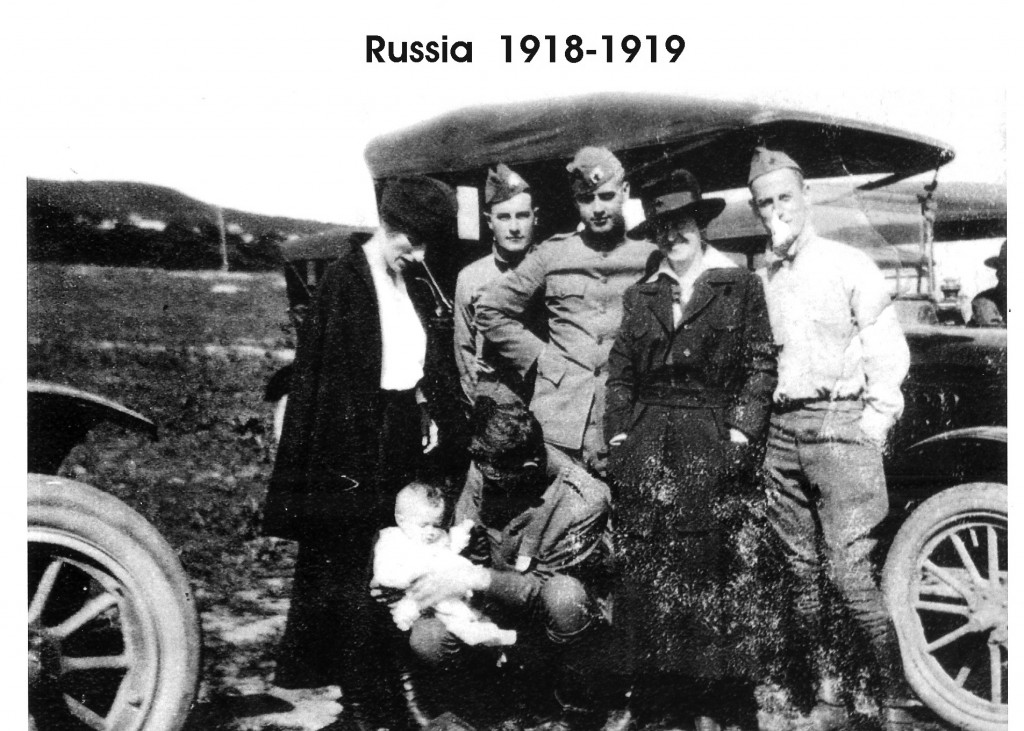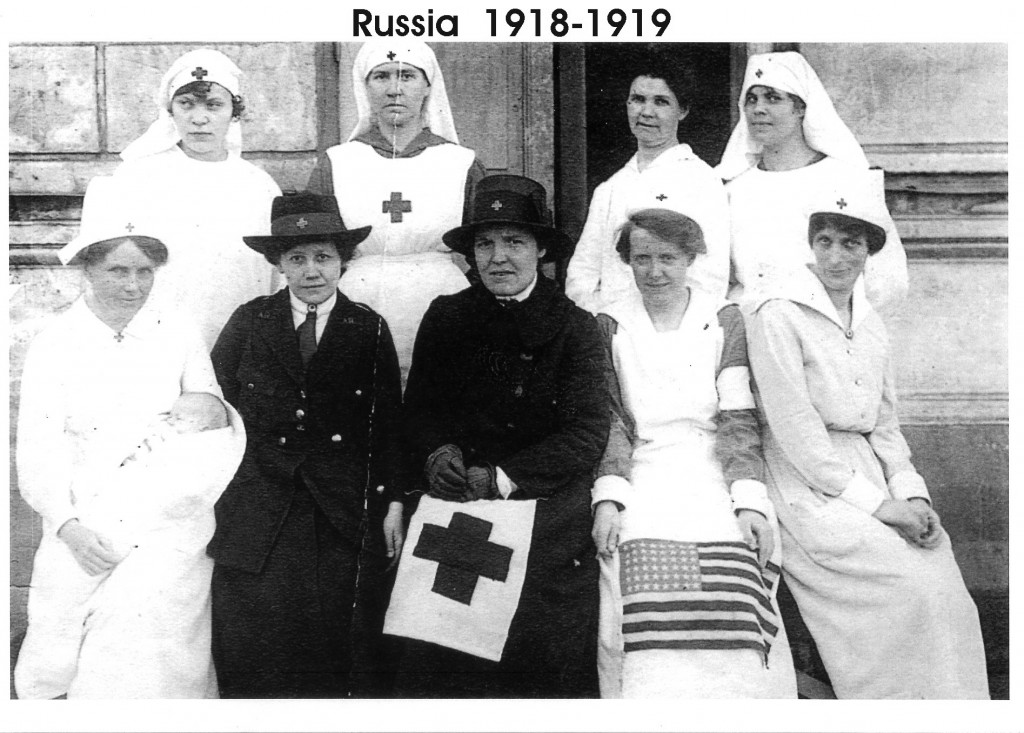From County Mayo to Philadelphia, to San Francisco, to Waikiki, to Vladivostok, to Pearl Harbor
By Susan Haggerty from the research of Margaret McMenamin–O’Byrne and Sean McMenamin, grand niece and nephew of Elizabeth McMenamin.
The harvest was the worst since the Great Famine and the same blight had returned to destroy the year 1879’s crops. It had also been the wettest year in Ireland since they began keeping records of such things.
As the rain fell on this 22nd day of April in 1879, John McMenamin looked down at his newborn daughter and felt little hope for her future. Both he and his wife, Maria (nee Mortimer) McMenamin, were born during the 1840s and they remembered all too clearly the devastation of that time. They lived in Belclare, Knockaraha West, located between the town of Westport and the holy mountain of Croagh Patrick. He farmed 18 acres for his landlord, the Earl of Lucan, and evictions of tenant farmers were happening all over Ireland.
Her father died six years after Elizabeth was born. Her mother had given birth to her ninth child six months previously. At 36, Maria McMenamin was a widow with nine children, ages six months to 16 years old. She kept the farm going and she made certain her children continued their education at the Brackloon National School.
Elizabeth’s Uncle Robert had been in California since 1864 and her aunt lived in Melbourne. When Elizabeth’s eldest sister Mary Anne turned 20, she boarded a ship to Australia but died on the voyage. Despite her heartache, it was inevitable that more of Maria’s children would leave. There were no opportunities for them if they stayed.
By the late 1890s, daughters Catherine (b.1870), Bridget (b. 1871), Gertrude, and Ellen (b. 1875) left for America. Bridget joined the Presentation Nuns in Berkeley, California, while Ellen settled in Albuquerque, New Mexico where she trained as a nurse. By 1900, Maria, her three sons–Robert (b. 1872), John (b. 1868) and Michael (b. 1877)–and youngest daughter Teresa (b. 1885) had saved the $10 for Elizabeth’s passage to America.
Elizabeth found employment in Philadelphia as the nanny for the children of a physician. Her employer saw that there was potential in this young Irish girl and suggested she attend nursing school.
In 1903, Elizabeth took the train to California to join her sisters. Bridget, now known as Sister Raphael, had enrolled Elizabeth in the Alameda Hospital Nursing School. She enjoyed hospital life and loved the cable cars that clanged up and down the streets of San Francisco. She graduated with her nursing degree in 1906 and immediately volunteered her services at the Red Cross.
At 5 a.m. on April 18, 1906, Elizabeth was awakened by a deafening noise and tremors. Nearby, buildings crumbled and fires dotted the city. More than 3,000 died while others fled to Golden Gate Park where a large field hospital was set up. Elizabeth worked endless hours at the field hospital, tirelessly treating the survivors of one of California’s famous earthquakes.
Needing a much-deserved vacation after six months at the field hospital, Elizabeth boarded a ship to Honolulu, Hawaii in the spring of 1907. As the ship docked, Elizabeth was amazed at the welcome the passengers received from the locals who pelted them with colorful streamers and placed leis made of flowers around their necks.
This tropical land had just been annexed by the United States in 1900. Elizabeth found the exotic Polynesian and Asian population mix fascinating. Along with the Europeans and American missionaries, there were also workers from the Philippines, Puerto Rico and Korea who’d been recruited to work the sugar cane and pineapple plantations. These two crops and the U.S. Army base were the major contributors to the island’s economy.
From the moment Elizabeth arrived she loved the island and soon decided to stay. She started a private nursing practice but also found a new challenge by renting rooms in Waikiki, Honolulu.
In 1910, a Bureau of Tuberculosis was established in Hawaii. In 1914, Elizabeth became one of the first Public Health nurses appointed to this organization. Leprosy also plagued the islands and the lepers were confined to the isolation of the peninsula of Molokai. Admiring the bravery and fortitude of these unfortunate souls, Elizabeth worked at the colony as a volunteer.
Realizing she wanted to devote her herself full-time to the causes of Public Health, Elizabeth joined the Red Cross in 1917. At that time, Russia was in turmoil in the aftermath of the revolution. The United States had sent about 10,000 soldiers to Siberia to protect the Czech soldiers and the expensive American military equipment stored at Vladivostok.
To help in this humanitarian cause, the Red Cross decided to send a unit to Siberia. Elizabeth was chosen to be part of this select group of 30 medical personnel. In November of 1918, the steamship left behind Hawaii‘s balmy temperatures while the thermometer dropped to minus 14 as the boat approached Vladivostok.
Elizabeth’s unit worked at the Russian Island Hospital to care for wounded Czech soldiers. At the same time, a train full of political prisoners, caked in filth and suffering from dysentery arrived at Nikolsk. The threat of a typhus epidemic loomed and several prisoners died.
Her next assignment was at the refugee hospital in Vladivostok where the nurses smeared kerosene over layers of clothes to combat the filth and flea infestations. Despite these conditions, Elizabeth thrived on the challenge of working with the refugees as their plight reminded her of those who suffered during the famine in Ireland.
One day a seriously ill young mother was admitted to Elizabeth‘s ward. The woman’s baby, half-starved, wrapped in dirty rags and suffering from bronchitis, was placed in a crib beside her bed. As the baby’s health improved, Elizabeth could not bear the thought of her returning to a life of extreme poverty and deprivation. The mother saw the love Elizabeth had for the child and knew the baby would have a better life with Elizabeth. The mother made the supreme sacrifice of allowing Elizabeth to adopt her daughter.
Elizabeth was overjoyed. She legally adopted the girl and named her Vladis McMenamin. When Vladis turned one year old, Elizabeth and the staff held a huge party to celebrate. A reporter from the Honolulu Star Bulletin stationed in Siberia covered the story about the single, Irish Red Cross nurse who adopted a baby in Russia. On October 9, 1919, the unit returned to Hawaii on a U.S. Army transport ship and a large group of friends met Elizabeth and her daughter at the dock in Honolulu.
Elizabeth and a friend bought a cottage in Honolulu. Vladis had no memory of the freezing temperatures, sickness and deprivation of Siberia, and she spent most of her time playing on the beaches of Waikiki.The following year on a Public Health service trip for the Red Cross, Elizabeth, 41, met Curtis Perkins, 51, who worked for one of the pineapple companies. They married a year later and bought a large property overlooking Pearl Harbor. They called it Palm Lodge and converted it into a small hotel with cottages on the grounds, which they rented to U.S. army personnel.
In 1928, they decided to sell Palm Lodge to a couple from New York but kept a house on the grounds for themselves and their little girl. Only a few years later, Curtis suddenly died in 1931. By this time, the New York couple had gone bankrupt due to the effects of the Great Depression.
Now a widow with a young daughter, Elizabeth bought back Palm Lodge and continued to operate the hotel and rent out the cottages. After school, Vladis helped her mother run the lodge. When she was 16, Elizabeth sent her daughter to a Catholic boarding school in Iowa to finish her education.
While Vladis was at school, Elizabeth met Charlie Warden, ten years her junior, who had come to Hawaii from the mainland U.S. on a contract to build ammunition depots for the U.S. Navy. The marriage fell apart soon afterwards and the couple divorced. Vladis finished her schooling and returned to Hawaii to help Elizabeth with the business.
A striking young woman, Vladis fell in love with Manny Sverdlin, a sailor from New York. Elizabeth lived and worked at the Palm Lodge but remained involved in the Nurses Association. She campaigned to have a building erected to house both the Hawaiian Medical and Nursing Associations on the grounds of Queens Hospital. In her honor, there is a chair in this building dedicated to her for her efforts.
In the morning of Sunday, December 7, 1941, Elizabeth heard loud noises coming from the harbor. An army officer who was living in a cottage at Palm Lodge banged on her door and shouted, “We are being attacked by enemy planes!” The explosions were getting louder as Elizabeth pulled on a coat headed out with the others towards the cane fields, later reaching Plantation Hospital which was set up to care for the wounded and misplaced.
She following day, Elizabeth discovered that her home, business and all her treasured possessions were destroyed. She moved in with Vladis’ family and learned that rebuilding the property was not an option because the U.S. Navy had annexed the whole area surrounding the property. Eventually, however, she received compensation for her property from the U.S. government.
Not wanting to be a burden to her daughter’s family, Elizabeth decided to visit her sister and cousins in California. Her youngest sister Teresa had joined Ellen in Albuquerque and Elizabeth stayed with them a while, taking consolation in their company.
As her health began to decline, she moved into a retirement complex in Pasadena. By this time, Vladis and Manny had three children and they sent her letters telling her about the events in her beloved Hawaii. In 1946, Elizabeth returned to Hawaii, moving into Vladis’ home outside Honolulu until brain surgery forced her to recover in a nursing home until she died of a heart attack on May 9, 1949.
Elizabeth McMenamin had been a highly-regarded nurse; a successful business owner; an adventurer who traveled to several foreign shores; a survivor who dealt with an earthquake, the effects of the Russian Revolution, the Great Depression and the bombing of Pearl Harbor; an independent thinker who adopted and raised the child of Russian refugees; and a woman also experienced marriage, widowhood and divorce. Although she began her life with little promise, she lived a life well-spent.




Well written article and a touching story of an inspirational woman – an Irish woman filled with courage, adventure and intelligence.